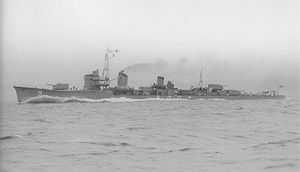Japanese destroyer Natsugumo (1937)
 Natsugumo underway on November 22, 1939 | |
| Career | |
|---|---|
| Name: | Natsugumo |
| Ordered: | 1934 Maru-2 Program |
| Builder: | Sasebo Naval Arsenal |
| Laid down: | July 1, 1936 |
| Launched: | May 26, 1937 |
| Commissioned: | February 10, 1938 |
| Struck: | November 15, 1942 |
| Fate: | Sunk in air attack, October 12, 1942 |
| General characteristics | |
| Class and type: | Asashio-class destroyer |
| Displacement: | 2,370 long tons (2,408 t) |
| Length: | 111 m (364 ft) pp 115 m (377 ft 4 in)waterline 118.3 m (388 ft 1 in) OA |
| Beam: | 10.3 m (33 ft 10 in) |
| Draft: | 3.7 m (12 ft 2 in) |
| Propulsion: | 2-shaft geared turbine, 3 boilers, 50,000 shp (37,285 kW) |
| Speed: | 35 knots (40 mph; 65 km/h) |
| Range: | 5,700 nmi (10,600 km) at 10 kn (19 km/h) 960 nmi (1,780 km) at 34 kn (63 km/h) |
| Complement: | 200 |
| Armament: | • 6 × 12.7 cm/50 Type 3 DP guns • up to 28 × Type 96 AA guns • up to 4 × Type 93 AA guns • 8 × 24 in (610 mm) torpedo tubes • 36 depth charges |
Natsugumo (夏雲 Summer Cloud) [1] was the fifth of ten Asashio-class destroyers built for the Imperial Japanese Navy in the mid-1930s under the Circle Two Supplementary Naval Expansion Program (Maru Ni Keikaku).
History
The Asashio class destroyers were larger and more capable that the preceding Shiratsuyu-class, as Japanese naval architects were no longer constrained by the provisions of the London Naval Treaty. These light cruiser-sized vessels were designed to take advantage of Japan’s lead in torpedo technology, and to accompany the Japanese main striking force and in both day and night attacks against the United States Navy as it advanced across the Pacific Ocean, according to Japanese naval strategic projections.[2] Despite being one of the most powerful classes of destroyers in the world at the time of their completion, none survived the Pacific War.[3]
Natsugumo, built at the Sasebo Naval Arsenal was laid down on July 1, 1936, launched on May 26, 1937 and commissioned on February 10, 1938.[4]
Operational history
At the time of the attack on Pearl Harbor, Natsugumo, under the command of Lieutenant Commander Moritaro Tsukamoto, was assigned to Destroyer Division 9 (Desdiv 9), and a member of Destroyer Squadron 4 (Desron 4) of the IJN 2nd Fleet, escorting the Philippines invasion forces to Vigan and Lingayen. She then assisted in the landings of Japanese forces at Tarakan, Balikpapan, Makassar and Java in the Netherlands East Indies. During the Battle of the Java Sea of February 27, she was on detached duty escorting the troop convoy and thus did not see combat. However, on March 1, she damaged USS Perch (SS-176) with depth charges.[5]
Natsugumo participated in the Battle of Christmas Island from March 31 –April 10, escorting the damaged cruiser Naka to Singapore, and then returning to Yokosuka on April 12 for repairs.
Natsugumo joined the escort for Admiral Nobutake Kondō’s Midway Invasion Force during the Battle of Midway from June 4–6, 1942. Afterwards, she was reassigned to the Ominato Naval District and assigned to patrols of the Kurile Islands and north Pacific to mid-July. However, on July 19, she received orders to escort the cruiser Chokai from Kure to Truk. From Truk, she made a transport run to Kwajalein and returned to Yokosuka by August 8.
On August 11, Natsugumo departed Yokosuka for Truk, and was part of the escort for Chitose at the Battle of the Eastern Solomons on August 24. She was assigned to patrols out of Truk in September, and ordered to Shortland Island in October. During the month of October, she made four “Tokyo Express transport runs to Guadalcanal. On the fourth run, while escorting Nisshin and Chitose, she went to the assistance of Murakumo which had been damaged during the Battle of Cape Esperance. Attacked by United States Navy aircraft on the night of October 11, near misses ruptured her hull, and she sank after only 39 minutes at position 08°40′S 159°20′E / 8.667°S 159.333°E approximately 90 nautical miles (170 km) west-northwest of Savo Island. The attack killed 16 crewmen, including her captain, Lieutenant Commander Tsukamoto; Asagumo took off her 176 survivors [6] She was removed from the navy list on November 15, 1942.
References
- D'Albas, Andrieu (1965). Death of a Navy: Japanese Naval Action in World War II. Devin-Adair Pub. ISBN 0-8159-5302-X.
- Brown, David (1990). Warship Losses of World War Two. Naval Institute Press. ISBN 1-55750-914-X.
- Hammel, Eric (1988). Guadalcanal: Decision at Sea : The Naval Battle of Guadalcanal, Nov. 13–15, 1942. (CA): Pacifica Press. ISBN 0-517-56952-3.
- Howarth, Stephen (1983). The Fighting Ships of the Rising Sun: The Drama of the Imperial Japanese Navy, 1895–1945. Atheneum. ISBN 0-689-11402-8.
- Jentsura, Hansgeorg (1976). Warships of the Imperial Japanese Navy, 1869–1945. US Naval Institute Press. ISBN 0-87021-893-X.
- Nelson, Andrew N. (1967). Japanese–English Character Dictionary. Tuttle. ISBN 0-8048-0408-7.
- Watts, Anthony J (1967). Japanese Warships of World War II. Doubleday. ASIN B000KEV3J8.
- Whitley, M J (2000). Destroyers of World War Two: An International Encyclopedia. London: Arms and Armour Press. ISBN 1-85409-521-8.
External links
- CombinedFleet.com: Asashio-class destroyers
- Natsugumo history
- GlobalSecurity.org: Asashio class destroyers
- Materials of the Imperial Japanese Navy
Notes
- ↑ Nelson. Japanese-English Character Dictionary. Page 52, 942
- ↑ Peattie & Evans, Kaigun .
- ↑ Globalsecurity.org, IJN Asashio class destroyers
- ↑ Nishidah, Hiroshi (2002). "Asashio class 1st class destroyers". Materials of the Imperial Japanese Navy.
- ↑ Allyn D. Nevitt (1998). "IJN Natsugumo: Tabular Record of Movement". combinedfleet.com. Retrieved 2008-02-06.
- ↑ Brown, David (1990). Warship Losses of World War Two. Naval Institute Press. ISBN 1-55750-914-X.
| ||||||||||||||